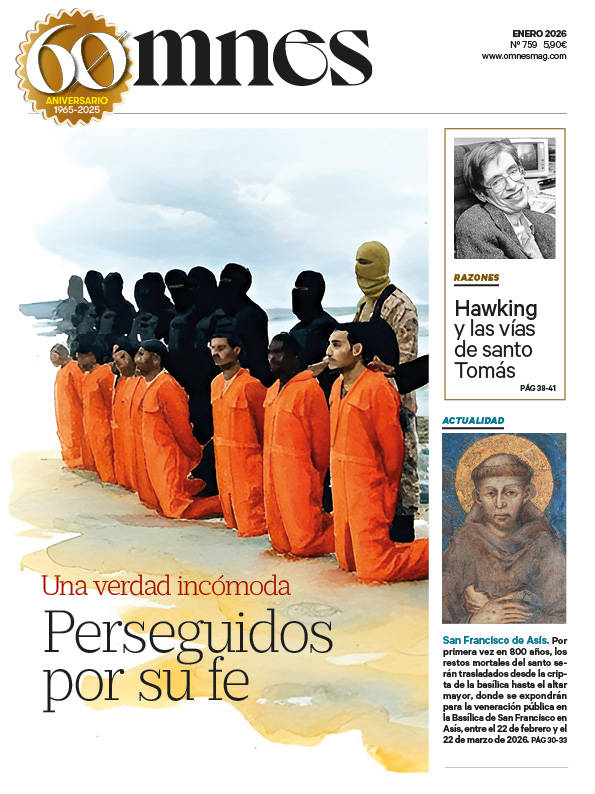How should the Pope's ministry be understood and exercised? This is a central question for the Catholic Church, for its relations with other Churches and Christian communities, as well as for the development of its evangelizing mission.
This is what the study paper published by the Dicastery for Christian Unity under the title "The Bishop of Rome. Primacy and Synodality in Ecumenical Dialogues and Responses to the Encyclical 'Ut unum sint'" (13-VI-2024).
In that encyclical, St. John Paul II invited in 1995 to rethink the ways in which the Pope can exercise his ministry, so that "he can fulfill a service of faith and love" recognized by all concerned (n. 95). Since then, the now Dicastery, formerly the Pontifical Council for Christian Unity, has been working to gather the responses to this invitation, especially those arising from the theological dialogues of ecumenism.
In the subtitle, "primacy and synodality" indicates not only the circumstance of the synodal process currently underway as a reference, but, more profoundly, the fact that the figure of the primate and his ministry are to be expressed within the framework of the synodality of the Church.
The text also responds to the findings of the Pope Francis’Today the Petrine ministry cannot be fully understood without this openness to dialogue with all believers in Christ" (Homily on the eve of the Conversion of St. Paul, January 25, 2014).
For reasons of space, we limit ourselves here to presenting the main theological issues involved and the final proposals of the Dicastery to the Catholic Church as a whole.
Fundamental theological issues
Francis has noted, "The path of ecumenism has enabled us to come to a deeper understanding of the ministry of the Successor of Peter, and we must trust that it will continue to do so in the future" (Homily on the eve of the Conversion of St. Paul, 25-I-2014).
As fruits of the ecumenical dialogues, four issues have been identified where new approaches or nuances have emerged.
1) The biblical foundations of the Petrine ministry. There is a recognition of Peter's special place, as a believer and as an apostle, among the twelve apostles; and that, precisely because of his fragility, he makes the grace of God and the primordial capital of Christ in the Church shine more brightly. Thus "three fundamental dimensions emerge in the Church's confession of faith: a communitarian dimension, a collegial dimension and a personal dimension" (n. 37). On the other hand, a distinction is made between the "mother Church" (of Jerusalem), within the New Testament, and the later primacy of the Church of Rome.
In addition to recognizing the special place of Peter, the category of the episcopate is emphasized, with mutual interdependence of help and service among its members and at the service of the whole Church. In this framework, the meaning of authority in the Church and the "Petrine function" are understood, with the special task of caring for and expressing unity, facilitating communication, mutual help or correction and collaboration in the mission. As successor of Peter, the Bishop of Rome has primacy.
2) "Divine right" was an argument used by Vatican Council I (1870) in its declaration on the Roman primacy (const. "Pastor aeternus"), while both the Orthodox and Protestants considered it simply a human or historical development. Today it is understood that this expression, ius divinum (as well as others such as "Petrine office"), is placed in the context of a universal primacy conceived within the collegiality of the bishops, the koinonia-communion and the historical dimension of the Church. The (doctrinal) essence of the primacy can be lived (and has been lived) in very different (historical) forms.
3) and 4) With regard to Vatican I's definitions of the primacy of jurisdiction and papal infallibility, various theological-ecumenical dialogue groups have pointed out the need to deepen the interpretation of Vatican I's dogmatic definitions, "not in isolation, but in the light of the Gospel, of the whole tradition and in their historical context" (n. 59).
Deepening Vatican I in the Light of Vatican II
As regards the latter, the historical context, we must remember: the risks of conciliarism; the interruption of the Council by the outbreak of the Franco-Prussian war; the distinction between the statements of the Council and its intentions (to ensure the unity of the Church in faith and love, as well as its freedom to proclaim the Gospel and its independence in the appointment of ecclesial offices); the distinction between the text and its interpretation is also important (cf. the Letter of the German bishops of 1875, endorsed by Pope Pius IX, with the affirmation that the episcopate is as much a divine institution as the papacy; and that the infallibility of the Pope is placed within the framework of the infallibility of the Church under certain conditions, and not above, but at the service of the Word of God).
Overall, it is understood that "Vatican I can only be correctly received in the light of the teaching of the Second Vatican Council" (n. 66). This resituated the papal ministry in its relationship to the episcopate (episcopal collegiality). And it re-established the connection between the sacramental and juridical "powers" granted through episcopal ordination, maintaining that the exercise of the bishop's authority is ultimately controlled by the supreme authority of the Church. In our day - the document observes - "the conciliar concept of collegiality has been further developed within the broader principle of synodality, especially in the teaching of Pope Francis" (n. 66; cf. Francis, Address on the occasion of the 50th anniversary of the Institution of the Synod of Bishops, 17-X-2015).
Yet, despite these declarations, the ecumenical dialogues still point to some difficulties with regard to certain principles: ensuring the expressions of infallibility in the light of the revelation given in Sacred Scripture; placing infallibility at the service of the indefectibility of the whole Church (the certainty that the gates of hell will not prevail against it); facilitating the exercise of episcopal collegiality; valuing the "reception" of doctrine by the faithful (pertaining to the "sensus fidei et fidelium").
Proposals of the Dicastery for Unity
In the Dicastery's proposals, a distinction is made between contributions, principles and suggestions for a renewed understanding and exercise of the Primacy.
a) Contributions. The text underlines that we are facing an opportunity to move forward in some directions: a common reflection on the nature of the Church and its mission in the world; the interdependence between primacy and synodality at all levels of the Church; the understanding of synodality as a fundamental quality of the whole Church including the active participation of all the faithful; the distinction and interrelation between collegiality and synodality.
As future steps in the theological dialogues, the following are proposed:
- Improve the connection and articulation between ecumenical dialogues, especially between Eastern and Western ones;
- Jointly address primacy and synodality as ecclesial dimensions.
- Keep in mind that "the primatial ministry ('one') is an intrinsic element of the dynamics of synodality, as are the communitarian aspect that includes the whole People of God ('all') and the collegial dimension that is part of the exercise of the episcopal ministry ('some')" (Francis, Address to the Orthodox-Catholic working group St. Irenaeus, October 7, 2011).
- Articulate this tripartite reflection at the local, regional and universal levels.
- Clarify the vocabulary (more precise meaning of synodality/conciliarity, collegiality, primacy, authority, power, administration, government, jurisdiction; understand the meaning of "universal Church" not as power but as authority at the service of communion.
- Promote the reception ("ecumenical reception") of the results of these dialogues so that they become a common heritage among the People of God, facilitate access to the documents of the dialogue, organize academic events, encourage responses and the local application of some of them.
- To give due value to the "dialogue of life alongside doctrine". In the words of Francis, "the dialogue of doctrine must be theologically adapted to the dialogue of life that takes place in the local and daily relationships between our Churches; these constitute an authentic 'locus' or source of theology" (Address to the Commission for Theological Dialogue between the Catholic Church and the Eastern Orthodox Churches, 23-VI-2022).
- Promote particular gestures and symbolic actions on the part of the Bishop of Rome, with creativity and generosity, encouraging theological reflection on them.
b) Principles and suggestions for the renewed exercise of primacy
In order to assume and respond to the proposals of the ecumenical dialogues and other studies on the renewal of the exercise of the primacy, the following lines are suggested:
- The inspiration of the principle of subsidiarity to facilitate the participation of all the People of God in synodality.
- The Catholic re-reception or official commentary of Vatican I, in the light of Vatican II, the ecclesiology of communion and the framework of the "hierarchy of truths" (UR 11). The Roman primacy should be explained by underlining the ecumenical convergence on the biblical foundation, the historical evolution and the theological significance of primacy and synodality. This may facilitate the understanding of Vatican I terminology.
- The clearest distinction between the different responsibilities of the Pope, highlighting his episcopal ministry at the local level (and in this sense the significance of the cathedral of the Diocese of Rome: St. John Lateran).
- Progress in the synodal configuration of the Church, with concrete reflections in institutions and practices, inspired by the Eastern Catholic Churches, and making use of the new means of communication, all according to the diversity of levels and cultural contexts.
- The deepening of the juridical status of the episcopal conferences, endowing them with the appropriate authority, taking the model of the ancient patriarchates (cfr. LG 23), as well as that of the continental episcopal bodies.
- The study of the possibility that the Synod of Bishops be a deliberative body, always with and under the successor of Peter.
- The possibility of constituting a permanent synod representing the episcopal college.
- The promotion of synodality ad extra through "conciliar communion" (meetings of church leaders to promote, through processes of joint discernment, the "practical ecumenism" of prayer, action and joint Christian witness).
- The invitation to other Christian communions to participate in Catholic synodal processes.
Conclusion
The conclusion of the document stresses that the primacy must be rooted in the mystery of the Cross, and that Christian unity is above all a gift of the Holy Spirit which we must implore in prayer, since "spiritual ecumenism" is the soul of the ecumenical movement.
This is how Francis put it: "Unity will not emerge as a miracle in the end. Rather unity emerges on the way; the Holy Spirit does it on the way. If we do not walk together, if we do not pray for one another, if we do not collaborate in the many ways we can in this world for the People of God, then unity will not happen! But it will happen on this road, in every step we take. And it is not we who do it but the Holy Spirit, who sees our good will" (Homily on the Vespers of the Conversion of St. Paul, 25-I-2014).








